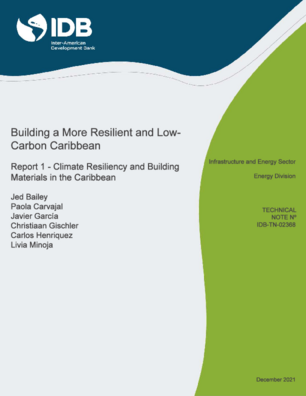Building a more Resilient and Low-Carbon Caribbean - Report 1: Climate Resiliency and Building Materials in the Caribbean
Date
Dec 2021
The Caribbean islands are among the 25 most-vulnerable nations in terms of disasters per-capita or land area, and climate change is only expected to intensify these vulnerabilities. The loss caused by climate events drags the ability of the Caribbean countries to invest in infrastructure and social programs, contributing to slower productivity growth, poorer health outcomes, and lower standards of living.
Within this context, building resiliency should become a priority for the Caribbean countries. The series “Building a more resilient and low-carbon Caribbean”, focuses on improving the resiliency, sustainability and decarbonization of the construction industry in the Caribbean. The results show that increasing building resiliency is economically viable for the high-risk islands of the Caribbean, generating long term savings and increasing the infrastructure preparedness to the impacts of CC.
Report 1 - Climate Resiliency and Building Materials in the Caribbean, presents a quantification of the economic losses caused by climate impact events in the Caribbean Region and correlate these figures with the most common construction materials, typically used in each of the countries building typologies. The losses caused by hurricanes concentrate mostly in the residential infrastructure and are mainly caused by weaknesses in roofs and their connection to the walls. The analysis suggests that improving the resiliency of outer walls and roofs in the Caribbean could significantly reduce the regions vulnerability to hurricanes and other climate impacts.
Within this context, building resiliency should become a priority for the Caribbean countries. The series “Building a more resilient and low-carbon Caribbean”, focuses on improving the resiliency, sustainability and decarbonization of the construction industry in the Caribbean. The results show that increasing building resiliency is economically viable for the high-risk islands of the Caribbean, generating long term savings and increasing the infrastructure preparedness to the impacts of CC.
Report 1 - Climate Resiliency and Building Materials in the Caribbean, presents a quantification of the economic losses caused by climate impact events in the Caribbean Region and correlate these figures with the most common construction materials, typically used in each of the countries building typologies. The losses caused by hurricanes concentrate mostly in the residential infrastructure and are mainly caused by weaknesses in roofs and their connection to the walls. The analysis suggests that improving the resiliency of outer walls and roofs in the Caribbean could significantly reduce the regions vulnerability to hurricanes and other climate impacts.




